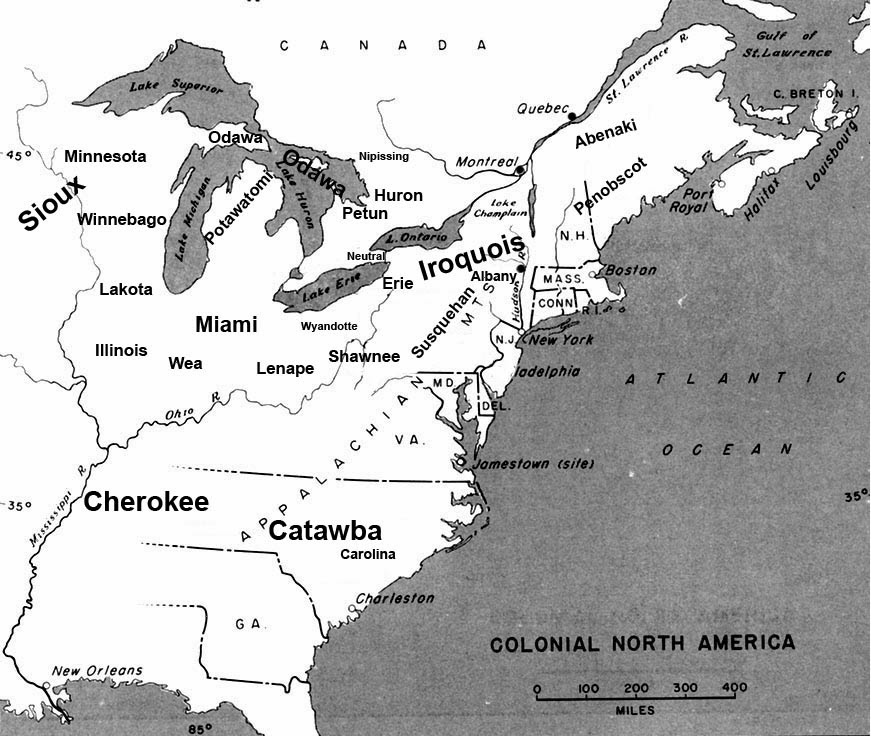Year: 1650-1700
 |
| Iroquois warriors attacking a French trading post |
Although the French and Iroquois War has been largely forgotten by Euro-American historians, it was the largest and bloodiest war to occur in North America until the U.S. Civil War of 1861-1865. Casualties are impossible to determine with any accuracy, but they may have been as high as a half-million.
The war began due to the confluence of the Haudenosaunee's long-time desire to subjugate neighboring enemy tribes with the preference of the British and Dutch colonial powers to have dealings with a unified, organized and centralized Indian entity---the Haudenosaunee.
The war also served the purpose of discommoding the French, who had laid claim to a vast area in the North American heartland, an area neither the British, the Dutch, nor the Iroquois wished them to control.
In the opening gambit of what became the Beaver Wars, the Seneca moved against the Wenro, a people who lived west of the Genessee River and east of Lake Erie. Although an Iroquian-speaking tribe closely related to the Seneca, the Wenro were traditional enemies of the Iroquois League.
In a brutal campaign lasting several years, the Seneca burned all of the Wenro villages and denuded their food stocks. Most of the Wenro fighting men were killed. The children and women of child-bearing age were forcibly adopted into the Iroquois tribes, and the remaining men enslaved. The few surviving Wenro fled west to seek asylum with the Erie and the Huron, where they quickly became assimilated. The Seneca occupied the Wenros' territory, and, in effect, the Wenro ceased to exist as a people.
Parenthetically, although slavery existed among the Iroquois, it was not widely practiced. Captives were, for all intents and purposes, slaves. However, the Iroquois' policy of adopting captives into the tribes included giving them full rights under Gayanashagowa.
During the campaign against the Wenro, the Mohawks likewise moved against the Pequots and Mohicans living in present-day Vermont, defeated them, and extended the boundaries of the Iroquois Confederacy to the Connecticut River. They then spread north, crossing the St. Lawrence River, and subjugated the Abenaki, Penobscot, Ottawa and the Ontario Peoples, taking control of much of current-day lower Quebec.
 |
| The tribes listed on this map were subjects of the Iroquois Empire |
The Confederacy moved against the Hurons and the Eries, and a confederation of tribes called the Neutrals, passing into modern-day Ontario and Ohio. They aggressively moved south and west.
By 1700, the Iroquois controlled a vast area centered on the Great Lakes stretching from Lake Nipigon in the north to the latitude of Nashville, Tennessee in the south, and reaching from the Mississippi River to beyond the Connecticut River to the Atlantic.
American schoolchildren are frequently taught that "New France" was only lightly colonized by missionaries and trappers; the French and Iroquois War is the reason. Unable to assert any real control over the American heartland, the French chose not to trouble themselves with their colonial holdings for a long period. It is little remembered, but the Iroquois managed to drive the French out of the Middle West completely for extended periods of time.
Many First Nations fled the Iroquois Empire. The mighty Sioux Nation, until then, a woodland folk of Wisconsin and Minnesota, moved west onto the treeless plains of Minnesota in what became the first stage of their transmutation into the quintessential bison-hunting tribe of the Great Plains.
Unfortunately for the Iroquois (and one might say unfortunately for the subsequent course of Native American history in North America), the Haudenosaunee leadership dealt unwisely with their subject peoples. Smaller, weaker tribes went the way of the Wenro; and larger and more powerful tribes, like the Miami, the Pottawatomie, the Cherokee, the Catawba, the Ojibwa, and the Shawnee, were expected to rendering humiliating tribute, being forced to provide their conquerors with foodstuffs, weapons, wampum, such money as they had, goods of all types, slaves, women and children for forcible adoption into the Iroquois tribes, and furs, particularly beaver pelts. This caused widespread poverty and starvation among the Native Americans.
Due to their policy of forcible adoption, the Iroquois people became a melting pot of Native American Nations, absorbing new ideas, customs, and styles (the haircut popularly called a "Mohawk" was in its origins, a Shawnee warrior hairstyle). The Susquehanna People of Pennsylvania were adopted into the Iroquois tribes en masse.
However, not one of the subject tribes was asked to join the League. This is in sharp contrast to the later decision of the Haudenosaunee to invite the displaced Tuscarora People to move into the metaphorical longhouse.
The brutality and destructiveness of the war, combined with the terrible policy of tribal subjugation followed by the Iroquois resulted in the rapid loss of their hard-won empire. When the French re-entered the Iroquois realm seeking to retake the land by force, they found thousands of willing indigenous allies to fight against the Haudenosaunee. By 1701, the Iroquois were forced to surrender Minnesota, Wisconsin, Michigan, Illinois, Indiana, Ohio, and Ontario; and the rest of their empire was stripped way from them by stages in hundreds of forgotten confrontations, by treaty, and during the French and Indian War and the American Revolution, particularly.
Worthy of consideration is the thought that had the Iroquois leadership of the 17th Century been more foresightful, they might have asked the subject peoples of their short-lived empire to join the League as equals in alliance against the strangers from across the sea. Had they done so, the colonizing Europeans would have faced a unified and determined native population, perhaps stretching across the continent and not so easily overcome. It is quite likely in that event, that the course of American history and the fate of the First Nations, would have been far, far different than it has turned out to be.
 |
| The burning of a Huron village |
No comments:
Post a Comment